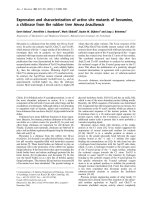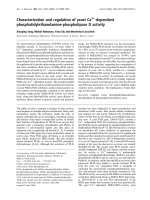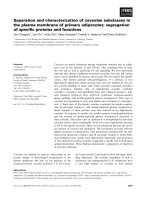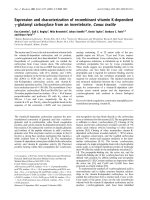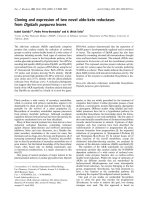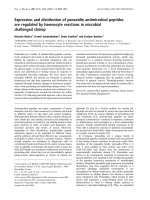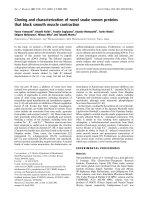Báo cáo y học: "Knowledge and practice of traditional healers in oral health in the Bui Division, Cameroon" ppsx
Bạn đang xem bản rút gọn của tài liệu. Xem và tải ngay bản đầy đủ của tài liệu tại đây (266.26 KB, 8 trang )
RESEARCH Open Access
Knowledge and practice of traditional healers in
oral health in the Bui Division, Cameroon
Ashu M Agbor, Sudeshni Naidoo
*
Abstract
Background: The majority of Cameroonians depend on traditional medicines for their health care needs and
about seven per cent of the average household health budget is spent on traditional medicines irrespective of
their incomes. The aim of the present study was to determin e the oral care knowledge and practices of Traditional
Healers (TH) on oral health delivery in the urban and rural areas of Bui Division of Cameroon and the objectives to
determine the cost of treatment and reasons why people visit TH.
Methods: The present study was cross sectional and utilized semi-structured questionnaires to collect data.
Results: The sample consisted of 21 TH and 52 clients of TH. Sixty two percent of the TH’s were above 40 years
and 90% male. The mean age was 46 years (range 20-77 years). Twenty four percent of the TH practiced as
herbalists and the remainder both divination and herbalism. Sixty seven percent of people in the Bui Division, who
patronize TH for their oral health needs, fall within the 20-40 year age group. There is little collaboration between
the oral health workers and TH and only 6% of all patients seen by TH are referred to the dentist. Socio-cultural
and economic factors affect the oral health care seeking behavior of patients in this area and only 6.5% of patients
visit dental clinics. Reasons for not attending dental clinics included high cost, poor accessibility, superstition and
fear. TH’s are not experienced in the treatment of pulpitis - the majority of patients who presented with toothache
had temporary or no relief, but despite this 67% reported being satisfied with their treatment. Sixty nine percent of
the patients visited TH because of low cost - the average cost of treatment with TH (approximately $5) is very low,
as compared to conventional treatment ($50).
Conclusions: Traditional healers are willing to co-operate with oral health workers in improving oral health. Since
they have a vital role to play in health care seeking attitudes in this community and barriers affecting the oral
health seeking behaviours should be removed. Mutual cooperation, collaboration and by integrating TH into
primary oral health care services needs to be increased.
Background
A traditional healer is a person who has no formal med-
ical training, but is recognized by the community in
which he/she lives as being competent to provide health
care by using plant, animal and mineral substances and
certain other methods based on social, cultural and reli-
gious background as well as the knowledge, attitudes
and beliefs that are prevalent in the community regard-
ing physical, mental and social well-being and the causa-
tion of the disease and disability [1]. According t o the
World Heath Organization (WHO), more than 80 per-
cent of Africans rely on traditional medicine and
indigenous knowledge to meet their health needs [1].
This is due to the fact that traditional medicine is acces-
sible, affordable, culturally and socially acceptable and
most people prefer it to the ‘exorbitantly priced’ conven-
tional Western medicine. With the legalization of tradi-
tional medicine as a complimentary health care service
to primary health care in Cameroon, the role of the tra-
ditional healer will be vital in the promotion of h ealth
especially in resource poor settings and rural areas
where they may be the only source of health care [2].
Since colonial times, Western medicine was the only
formally accepted medicine in Cameroon. Traditional
medicinal practices were condemned as witchcraft or
sorcery and discouraged. Despite this, the practice of
traditional medicine has survived clandestinely in
* Correspondence:
Department of Community Dentistry, University of the Western Cape,
Tygerberg, South Africa
Agbor and Naidoo Journal of Ethnobiology and Ethnomedicine 2011, 7:6
/>JOURNAL OF ETHNOBIOLOGY
AND ETHNOMEDICINE
© 2011 Agbor and Naidoo; licensee BioMed Central Ltd. This is an Open Access article distri buted under the terms of the Creative
Commons Attribution License ( icenses/by/2.0), which permits unrestricted use, distribution, and
reproduction in any medium, provide d the origi nal work is properly cited.
Cameroon. One of the main reasons Cameroonians still
favor traditional medicines is financial - they resort to
traditional medicine because they cannot afford pharma-
ceutical medicaments or conventional medical care [3].
The oral health care work force in Cameroon consists
of 220 dentists all trained a broad. Nearly all are located
in the two big cities of Douala and Yaoundé serving just
20% of the country’s population. On the other hand, it
is estimated that there are more than 20 000 traditional
healers (TH) in the country serving both the rural and
urban population. Rural populations do not have access
to the services of trained oral health personnel due to
cost constrai nts and poor accessibility. Today, seven per
cent of the average household health budget is spent on
traditional medicines. Nearly twice as many people from
poor households rely on traditional medicine as do peo-
ple f rom rich households [4]. The recognition and inte-
gration of traditional medicine into the health system of
Cameroon was officially proposed in 1981. Since then,
traditional medicine has been recognized, but not regu-
lated by the Ministry of Health. In 1995, a presidential
decree no. 95-040 of July 3, 1995 gave TH in Cameroon,
the authorization to create associations at both provin-
cial and national levels to manage their activities [5].
In recognition of the fact that traditional medicine is
“the most affordable and accessible system of health
care for the majority of the African rural population,”
the Organization for African Unity (now the African
Union) declared the years 2001-2010 to be the ‘Decade
for African Traditional Medicine’. The aim of this
declaration was to bring together all the stakeholders in
health care in an effort to make traditional medicine
“safe, efficacious, affordable and available to the vast
majority of African people” [6]. One of the ta sks of t he
WHO (Africa Region) is to assist countries in ensuring
that the African population enjoys improved levels o f
oral health and functi on through a significant reduction
of all oral diseases and conditions that are prevalent i n
the region, with equitable access to cost-effective quality
oral health care and adoption of healthy lifestyles.
Despite much research in recent times regarding
health (medical) sector collaboration with TH, there is
paucity of literature with regard to the role of TH in the
provision of oral health care and in the diagnosis and
management of the common oral problems including
the oral manifestations of HIV/AIDS. Given shrinking
health budgets, economic constraints and the diminish-
ing capacity for oral health personnel to handle the bur-
den of oral diseases throughout much of Sub-Saharan
Africa, it would seem logical to develop and enhance
co-operation and collaboration between the formal oral
health services and TH to bring available resources in
the health sector to serve the population for better oral
health and HIV/AIDS prevention.
Traditional healers are considered to be effective
agents of change as they command authority in their
communities, function as psychologists, marriage and
family counselors, physicians and legal and political
advisors [7]. They are also the legitimate interpreters of
customary rules of conduct, morality and values. TH
provide client-centered, personalized health care that is
culturally appropriate and tailored to meet the needs
and expectations of the client paying special respect to
social and spiritual matters [8].
Lewis et al. [9] reported on the oral health care
knowledge and practices of African TH from two com-
munities: Zonkizizwe and Dube in the Gauteng Pro-
vince, South Africa. According t o their findings, more
than 90% of TH from both areas correctly identified
photographs of gingival inflammation, dental caries
and oral candidiasis. More than half reported patients
presented with mouth problems such as toothache,
swollen gums and oral candidiasis. Considering that
oral candidiasis has been reported as the most preva-
lent oral manifestation of HIV/AIDS and the fact that
almost all TH can recognize oral candidiasis suggests
thatTHcouldplayanessentialroleintheeffortsto
address early diagnosis of the oral manifestations of
HIV/AIDS [7,9].
A study carried out in Nigeria [10] found that TH
were providing dental care, but their work was not inte-
grated with that of a dentist. He reporte d that while TH
were open to collaborating with dental professionals, the
reverse was not true. TH are mo re numerous than den-
tal and medical practitioners and are widely accepted by
a large proportion of the population, therefore it is l ogi-
cal that their work be integrated with that of dental and
medical practitioners. In Africa and some parts of Asia
chewing sticks are used for p laque removal [11,12].
Most plants used as chewing sticks contain fluoride
and/or have antimicrobial, anti-cariogenic or anti-
inflammatory properties [12,13].
Ngilisho et al. [14] reported that sixty per cent of the
villagers in Tanga region, Tanzania who suffered from
toothache sought treatment from TH. They were treated
with local herbs and obtained pain relief for more than
six months. The authors concluded that the presence of
modern health facilities did not influence the villagers’
use of TH. Hence, it could be surmised that TH play an
important role in the relief of acute pain, in underserved
rural areas.
Therapeutic methods used by African TH include psy-
chosocial counseling , simple surgical procedures, rituals
and symbolism [15]. The types of medica tions used by
TH can be classified as preventive and prophylactic
medications [16], treatmen t for ailments [17] and medi-
cations used to “destroy the power in others” [18-22].
The need to identify and recognize the benefi cial effects
Agbor and Naidoo Journal of Ethnobiology and Ethnomedicine 2011, 7:6
/>Page 2 of 8
of traditionally use d plants and medicaments has bee n
recognized [19].
Hamza et al. [18] investigated the antifungal activity of
traditionally used Tanzanian plants and found good cor-
relation between traditional therapeutic use and in vitro
antifungal activity and corroborated the importance of
ethnobotanical surveys for screening plants as a poten-
tial source for bioactive components that may have pre-
ventive, prophylactic or treatment properties for oral
and other diseases. Sarita and Tuominen [23] investigat-
ing the pattern of utilization of medical and dental
health care services in rural Tanzania reported that indi-
genous home remedies were the o nly treatments used
for managing dental problems, while for medical pro-
blems a TH was the most commonly used. Since the
pattern of utilization of heal th care services differed for
medical and dental problems, it should be taken into
account when planning comprehensive health care ser-
vices for rural African societies.
However, one needs to be aware that some traditional
practices may be harmful for example, the practice of
extracting tooth buds and of rubbing herbs on to the
gingivae of children to treat fevers and diarrhea, as has
been documented in countries such as Tanzania and
Uganda [14]. There is a need f or health education pro-
grammes [14]. Discouraging the adoption of deeply
rooted traditional practices that are potentially hazar-
dous to health and oral healt h needs to be made a pub-
lic health priority [15]. This could be achieved by
educating not only the general public, but also the TH
and community leaders that convey the knowledge to
their people.
There have been many instances where TH have col-
laborated with the health sector. Wilkinson et al. [24]
investigated the potential for TH to act as tuberculosis
(TB) treatment supervisors. Although only four per cent
of the study population believed that TH could cure TB,
84% stated that t hey would consider choosin g a healer
as a treatment supervisor. Eighty eight per cent of hea-
lers reported hav ing referred patients with suspected TB
to hospitals for treatment and all the healers were keen
to collaborate with health services and to act as treat-
ment supervisors.
In an earlier report investigating the relationship
between traditional and modern medicine Edwards [25]
found that while traditional and modern practitioners
worked from different theoretical orientations, they were
in significant agreement as to both diagnosis and treat-
ment of patients when faced with the same limited
choice o f options. Furthermore, patients perceived both
the traditional and modern practitioners as being more
or less equally helpful.
In Uganda, THETA (Traditional and modern health
practitioners together against AIDS and other diseases),
is promoting collaboration between traditional and bio-
medical health workers in the prevention and care of
sexually transmitted infections (STIs) including HIV/
AIDS. Projects involve collaboration in clinical trials to
study the effectiveness of herbal treatments for opportu-
nistic infections and to empower traditional medicine
practitioners to offer counseling and education on STIs /
AIDS.
A study by Homsy and King [26] concluded that tradi-
tional healers could be trained as counselors and educa-
tors to disseminate HIV/AIDS information and
prevention practices between their peers and commu-
nities. Case studies indicate that TH are capable of per-
formin g at least as well as their biomedical counterparts
as AIDS educators and counselors. Of concern to
Homsy and King [26] however, was the failure of many
projects to provide systematic follow-up to healers after
their initial training. Such follow-up is essential to s up-
port healers in dealing with unfamiliar issues such as
condom use and death and dying. Masauso Nzima et al.
[27] carried out a similar study in four Copperbelt
towns in Zambia whereby TH received AIDS training
and how to counsel clients on safe sex behaviors,
together with follow-up monthly meetings.
A qualitative investigation by Abdool Karim [28]
exploring potential preventative health roles that TH
could play with regard to HIV prevention, recom-
mended that TH be incorporated into AIDS prevention
programmes where they can play a role in community-
based AIDS education. There is increasing recogni-
tion on the role of TH in preventing and controlling
HIV/AIDS and other sexually transmitted infections
(STIs) [29].
Green [29] made some important recommendations
for one to consider when planning collaborative work
with TH:
• Be fair and democratic in selecting healers for
training
• Try to identify and train motivated healers who are
respected in their communities
• Do not make membership of a TH’s association a
requirement for participation in HIV/AIDS training
• Encourage healers to promote sexua l abstinence
among youth, and fidelity within marriage among
adults.
The World Health Organization (WHO) and other
official groups have acknowledge the potential effective-
ness of T H as prim ary caregivers and the potential effi-
cacy of their treatments in the fight against HIV and
AIDS, sexually transmitted disease, and other infectious
diseases [30]. The WHO also supports the integration
of Western medicine and traditional healing and
Agbor and Naidoo Journal of Ethnobiology and Ethnomedicine 2011, 7:6
/>Page 3 of 8
encourages referrals between the t wo groups. In South
Africa, TH have their own organization (Board of TH)
that is recognized by the Department of Health and by
the Ministry of Health respectively. Among the Zulu
population, TH serve many functions in the community,
such as the role of a minister of religion, legal advisor,
healer, custodian of history and tradition and commu-
nity organizer [17,31,32].
Traditional healing has always been a component of
health care in Cameroon but the actual contribution of
TH to oral health care in the Bui Division of Cam eroon
is not known.
The aim of the present study was to assess the knowl-
edge and practices of TH and determine the extent to
which TH can diagnose oral conditions and how they
can be incorporated into oral health care and prevention
of oral diseases.
Methods
This is a cross-sectional study de sign in rural and urban
populations of Bui Division, in the North West Region
of Cameroon. In Bui Division, general and oral care
health delivery is carried out by 9 medical doctors and 1
dentist serving a population of 133 000 people. There
are more than 500 TH registered with the TH’s associa-
tion and treat common problems like diarrohea and
malaria to more complex cases involving bone setting
and serving as traditional birth attendants.
Inhabitants residing in rural and urban areas of Bui
division who sought treatment in hospital or from TH’s
for oral problems and individuals practicing as TH i n
the Bui divisions were interviewe d. TH were randomly
chosen from each of the sub-clans in the 3 towns
located in Bui division. Bui division is one of the five
divisions in the North West Region of Cameroon.
Kumbo, it’s headquarters is the second largest town in
the region and is located 110 km from the regional capi-
tal, Bamenda. The area i s mountainous with poor road
networks and basic infrastructure and the majority of
inhabitants are subsistent farmers. The subclans division
is based on 3 linguistic communities - the Nso, Oku
and Noni whose headquarters are based at the towns of
Kumbo, Oku and Nkor Noni respectively.
A workshop was held to determine the knowledge and
practices of TH on oral diseases and oral health care.
The objectives were to determine their knowledge of the
common oral diseases, the type of treatm ents adminis-
tered to treat oral problems and the cost of TH’s care as
compared to conventional dental treatment provided in
local dental clinics. Colour photographs of common oral
diseases and oral lesions were used for pre-testing of the
knowledge of TH, a short training workshop was carried
out followed by post-testing 3 months after the initial
training workshop.
Questionnaires were administered to a convenience
sample of inhabitants who used the servi ces of THs. TH
questionnaires elicited data regarding their oral health
knowledge and willingness to s creen and educate their
clients about oral health care. Closed and open ended
questionnaires were used for both groups. Informed
consent was obtained from all the participants.
Data were categorized, coded and then entered into
thecomputer.ThedatawascapturedinExcel.Basic
descriptive analysis was done using the Excel environ-
ment. The database was imported into SPSS
®
to per-
form complex statistical analyses. Descriptive statistics
were used to describe the demographic factors. The
independent t-test was used to determine correlation
between the scale variables. The Chi-square test was
used to determine the association between the nominal
and the ordinal variables.
Results
A total of 21 TH and 52 clients participated in the
study. The ages of the TH ranged from 20 to 77 years
with the average age o f 46.09 years and a standard
deviation of 14.29. Sixty two percent of the TH was
over 40 years and 90% were male. More than a fifth
(23.8%) of the TH were herbalists and the remainder
practiced both divination and herbal medicin e. Of the
52 clients, slightly more than half were males. The age
distributions can be seen in Table 1.
(a) Traditional healers
Seventy one percent of the TH had a primary and high
school education, but had no formal training for their
profession. More than two thirds (76.2%) were registered
with the TH’s association and the average duration of
training of TH was 7.5 years (range 4 to 10 years). The
average duration of practice of TH was 21 years (range
2 to 41 years). Three quarter of the TH were about half
an hour away from the nearest health facility. All TH
reported that if necessary, they referred patients to other
health care workers (Figure 1).
Seventy one percent of TH reported that they knew
the cause of HIV/AIDS and 67% stated that they could
treat oral HIV lesions. Some of the causes of AIDS/HIV
reported by TH included unprotected sex, contaminated
needles and contact with blood. All TH were able to
Table 1 Age distribution of TH and their clients
Age range (years) TH N(%) Clients N(%)
< 20 yrs 1 (4.6) 8 (15.4)
21-30 yrs 1 (4.6) 22 (42.3)
31-40 yrs 6 (28.6) 13 (25.0)
>40 years 13 (61.9) 9 (17.3)
Total 21 (100) 52 (100)
Agbor and Naidoo Journal of Ethnobiology and Ethnomedicine 2011, 7:6
/>Page 4 of 8
accurately detect candidiasis, dental caries and gum
diseases from photographs after a training workshop.
There was a significant increase in knowledge in the
diagnosis of aphthous ulce rs, tongue cancer, and Kaposi
sarcoma (Table 2).
There was a statistical significant increase (p = 0.004)
in knowledge from pre-test to post-t est for all the six
diseases.
Tables 3 shows the treatment and materials used for
oral lesions. The barks of trees, herbs and roots are
used to make mouth washes. Their reported benefits
include pain relieve and softening tooth before
extractions
(b) Clients
Fifty two participants who reported having oral pro-
blems and had dental treatment were interviewed. The
age of participants ranged from 9 to 70 years; SD =
0.503 (Table 1). More than half live below $100 per
month. Most patients reported visiting the TH because
of the low cost (69%), TH understand their problems
better (12%), fear of death from tooth extractions (8%),
and hospital or clinics were too far away (5%). More
than two thirds (67.3%) were satisfied with the treat-
ment the TH provided and those who were dissatisfied
reported that there was no significant change in their
presented complaint and pain persisted even af ter treat-
ment. Table 4 shows the proximity of TH and health
facilities. For 76% it takes about 30 minutes to get to a
TH and for more than half an average of 4 hours to get
to the nearest oral health care facility.
Discussion
(a) Traditional healers
The fact that more than two thirds of TH in the present
study were older than 40 years implies that if speedy
interventions to incorporate them into oral health edu-
cation and promotion efforts are not made, the legacy
of the use of traditional medicines in the treatment of
oral lesi ons may be lost [33]. The most senior TH were
illiterate, but form the majority of the trainers and are
respected community leaders; therefore there is the exis-
tence of knowledge transfer from the elderly to younger
healers. The higher preponderance of males in the
TH sample is because traditional medicine is a male-
dominated profession in the Bui division concurri ng
with the findings of Gessler et al. [34].
Less than half of the TH had formal training. Further-
more, the training was not standardized, as most were
trained by fathers, uncles and other senior TH. The
average duration of training for an herbalist was 7.5
years with training ranging from 4 to 10 years depend-
ing on the ability of the apprentice. It can be concluded
that because of their longer training, herbalists have
good knowledge and skills to treat patients, unlike divi-
ners who do not undergo any form of apprenticeship.
Most of the TH in the Bui division diagnose and treat
problems. This finding is similar to studies carried out
in the Tanzania and Zambia [2,35]. Of the 21 TH in
this study, only 76% of them are registered with the
Traditional Healer’s Association of Cameroon. Increas-
ing the number of regist ered TH may be a way of regu-
lating the profession and controlling bad practices.
Despite the fact that more than two thirds of TH are
close to basic primary health facilities, most of their
referral for oral problems are to medical doctors and
other TH. Only few patients were referred to the dental
clinic. Most patients visit TH first, before a medical or
dental practitioner [36-39]. Some encourage the use of
self medication including herbs and common analgesics
Figure 1 Referral by TH.
Table 2 Identification of common oral conditions from photographs
Lesion/Disease Pre-test correct Post-test correct Percentage difference p value
A Caries 21 (100) 21 (100) 0.00 1
B Gum Disease 11 (53.33) 21 (100) 46.67 < 0.001
C Tongue Cancer 2 (9.52) 18 (85.68) 76.16 0.015
D Kaposi Sarcoma 4 (19) 17 (80.92) 61.92 0.003
E Aphthous Ulcers 2 (9.52) 19 (90.44) 80.92 0.004
F Candida 17 (80.92) 21 (100) 19.08 0.036
MEAN 10 (45.38) 20 (92.84) 79.87 0.004
Agbor and Naidoo Journal of Ethnobiology and Ethnomedicine 2011, 7:6
/>Page 5 of 8
because of the perception that referral to a dental clinic
will be very expensive.
Seventy one percent of TH reported that they were
aware of the causes of HIV/AIDS and this is compar-
able to the findings of Pelzer and colleagues [36]. TH
need to be e ducated on other practices that can trans-
mit the virus and sho uld also be trained in HIV coun-
seling, condom distribution, community HIV/AIDS and
STI education. Sixty seven percent of TH reported that
they treat patients for mouth problems. With regard to
HIV infections, many TH report that their treatments
help patients to regain their appetite, cure the opportu-
nistic lesions and increase the “red blood cell count”.
Their perceived impression is, that if yo u can in crease
the red blood cells, the patient feels better [2,3,33,
35,36].
Pre-testing the TH for knowledge of or al lesions
revealed that they could diagnose candidiasis, dental car-
ies and gum diseases from photographs of 6 oral lesions.
Similar findings had been found by Lewis et al. [6] and
Rudolph et al. [8] in South Africa. All the TH reported
that they would be willing to learn more about common
mouth problems in adult and children and were willing
to screen patients for oral manifestations of HIV.
Furthermore, they were also interested in educating
their clients about oral health care if given adequate
training. A study carried out in Yaoundé, Cameroon has
long-established that although the ed ucation level varies
widely, traditional practitioners have a deep thirst for
knowl edge and yearn for greater inclusion into the pub-
lic health sector [3]. This is supported by other studies
from Africa [2,33,35,36].
In the present study, treatment for oral disease by TH
included the use of mouth washes, pain relieving herbs,
fumes from burnt food spices used to remove “worms”
from infected teeth and the application of powder made
from bark o f trees to stop pain. The use of natural
products for the treatment of other oral disease like
herpes zoster, tuberculosis, candidiasis and toothache
have also been reported by Kisangau [33] and Tapsoba
and Deschamps [19].
However, one of the problems associated with the use
of herbal treatments is that some of them have never
been rigorously evaluated or standardized (in terms of a
standard pharmacopeia) [2]. They are often poorly
packed and preserved, limiting their usefulness, accessi-
bility and shelf life. Hillenbrand [3] reported that all
healers interviewed acknowledged that the plants that
they use can be toxic as some of their ingredients can
have profound effe cts on the mouth, stomach, and the
entire gastro-intestinal tract with severe consequences
like “iatrogenic gastritis and colitis”. A common com-
plaint about traditional medicine is that healers claim
they can treat everything whether they have a sound
knowledge of the aetiology or patho-physiology of the
disease or n ot. This calls for caution about the efficacy
of their treatment modalities.
(b) Clients
Two thirds of clients in the present study were aged
between 21-40 years and this could be due not only to
the small sample size, bu t also the demographic compo-
sition of the area since in Cameroon a larger proportion
of the population is younge r. Maclean and Bannerman
[36] found that a higher number of older people visited
TH than the younger age groups.
Kayombo and colleagues [2] have reported that the
involvement o f oral health into the primary health care
system is sti ll minimal. The average cost of treatment
from TH is very low (approximately $5) as compared to
conventional treatment ($50). Pelzer et al. [36] suggested
that patients visit TH because they provide client-cen-
tered and personalized health care that is tailored to
meet their needs and expectations, paying special
respect to social and spiritual matters. Nevertheless 32%
were not satisfied by the treatment provided by the TH,
mainly because the pain persisted despite the traditional
remedies provided. Treatment for pulpitis was often
short-lived.
Reasons for not taking up oral health services included
poor accessibility to oral health facilities and unafford-
able private dental care. Furthermore, people were afraid
of dental clinics and preferred cheap palliative treat-
ments instead [40]. There was also a lack of knowledge
of the role of the dental team as efficient oral health
care providers as there is an acute shortage of oral
health care workers (only one dentist, 2 dental therapists
and 4 other dental auxiliaries serve this population of
about 800 000 people). More than a third reported only
visiting the hospital or clinic when their situation got
Table 3 Type of treatment given by TH
Type of treatment provided Percentage
Mouth wash from bark of tree extracts 67.0
Pain relieving herbs 11.0
Fume inhalations(from burnt spices in palm oil) that
remove worms from infected tooth
11.0
Softens tooth before extractions 5.5
Application of powder from bark of tree to stop pain 5.5
Table 4 Proximity of patients to TH and health facilities
Time Distance of patient
from TH N (%)
Distance from oral
health facility N (%)
< 30 min 38(76) 2(3.9)
30 min - 1 hr 7(14) 17(33.4)
1 hr - 4 hrs 4(8) 5(9.8)
>4 hrs 1(2) 27(52.9)
Agbor and Naidoo Journal of Ethnobiology and Ethnomedicine 2011, 7:6
/>Page 6 of 8
worse (e.g. development of dento-alveolar abscesses,
Ludwig’ s angina). Some TH do refer patients because
they are aware of their limitations [41,42].
Proximity of the health care professional is a determi-
nant in oral care delivery. In the Bui Division, primary
oral health care is underdeveloped with poor access to
basic oral health care. Poor access to oral health facil-
ities limits patient’s choices and hence patients prefer to
patronize a TH rather than having to travel for more
than 4 hours to see an oral health care worker.
Conclusion
The majority of Cameroonians depend on traditional
medicines for their health needs with about 7% of the
average household health budget is spent on traditional
medicines irrespective of the earning of its inhabitants.
All TH operate full-time and greatly out-number the
oral health care providers.
Most people still rely on TH because their treatment is
affordable and TH share their patient’s culture, beliefs and
values and understand their expectations of health care.
Hence they are generally more accessible and acceptable
as health care providers. Their methods of treatment are
effective and less invasive in certain cases, as they make
use of local herbs and medicinal plants, though there are
sometimes hazards associated with their treatments.
In view of the fact that factors affecting the oral health
seeking behavior of patients in this region cannot be
easily removed in a short term, a multisecto rial -popula-
tion based primary health care approach may be an
option to break down some o f these barriers. This
should be based on an empowerment model which will
integrate basic oral health care to all aspects of health
care at PHC level equip TH with tools t hat that can
assist them with the dia gnosis and recording of oral dis-
ease, with appropriate referrals. Because TH have close
contact with t he community, simple basic dental prac-
tice applications like the Basic Package of Oral Care
(BPOC) can be inculcated into their practice. They may
also play a role in educating the community on the use
of fluoride in the prevention of dental caries (AFT),
restoring teeth using the atraumatic restorative (ART)
and minimal invasive (MIT) techniques and carrying out
emergency care by simple extractions.
From the findings of the present study, we can con-
clude that TH play a vital role in the health seeking
behaviors of the community. Improving their knowledge
and cooperation with oral health workers will serve to
reduce inequalities and improve the standard of oral
health care. TH can form a bridge linking the commu-
nity to oral health care providers; can serve as a valuable
tool for population-based health prevention and promo-
tion approaches in achieving health for all. Oral health
workers in this region have to increase cooperation and
collaboration with TH. Therefore, traditional healers
could be trained as counselors and educators to dissemi-
nate oral health information and carry out minor pre-
vention practices within their communiti es. A follow-up
study in collaboration with plant scientists to investigate
the plants being used by TH for healing oral problems
will be useful.
Acknowledgements
MA would like to thank with sincere gratitude his sponsor Prof. Aubrey
Sheiham for making his dreams of postgraduate study a reality.
Authors’ contributions
MA contributed to the design of the study as well as acquisition of data, its
analysis and interpretation and was involved in the drafting of the
manuscript. SN made substantial contributions to the conception and
design and in the drafting and revision of the manuscript. All authors read
and approved the final manuscript.
Competing interests
The authors declare that they have no competing interests.
Received: 23 October 2010 Accepted: 15 January 2011
Published: 15 January 2011
References
1. World Health Organization: Traditional medicine strategy 2002-2005.
World Health Organization Geneva: World Health Organization; 2002, WHO/
EDM/TRM/2002.1.
2. Kayombo EJ, Uiso FC, Mbwambo ZH, Mahunnah RL, Moshi MJ, Mgonda YH:
Experience of initiating collaboration of TH in managing HIV and Aids in
Tanzania. J Ethnobio Ethnomed 2007, 3:6.
3. Hillenbrand E: Improving Traditional-Conventional Medicine
Collaboration: Perspectives from Cameroonian Traditional Practitioners.
Nordic J African Studies 2006, 15:1-15.
4. Ministère de la Sante Publique: Stratégie Sectorielle de Santé: Analyse
Situationnelle du Secteur Sante au Cameroun. Paper prepared by Ministry
of Public Health, Yaounde, Cameroon; 2002.
5. Republic of Cameroon: Presidential decree no. 95-040. 1995.
6. Kofi-Tsekpo M: Institutionalization of African traditional medicine in
health care systems in Africa. Afr J Health Sci 2004, 1-2:i-ii.
7. Rudolph MJ, Ogunbodede EO, Mistry M: Management of the oral
manifestations of HIV/AIDS by traditional healers and care givers.
Curationis 2007, 30:56-6.
8. King R, Homsy J: Involving traditional healers in AIDS education and
counseling in sub-Saharan Africa: A review. AIDS 1997, 11(Suppl A):
S217-225.
9. Lewis HA, Rudolph MJ, Mistry M, Monyatsi V, Marambana T,
Ramela P: Oral health knowledge and original practices of African
traditional healers in Zonkizizwe and D ube, South Africa. SADJ
2004, 59:243-246.
10. Ogunbodede E: Dental care: the role of Traditional Healers. World Health
Forum 1991, 12:444-445.
11. Akpata ES, Akinrimsi EO: Antibacterial activity of extracts from some
African chewing sticks. Oral Surg, Oral Med, Oral Pathol 1977, 44:717-722.
12. Enwonwu CO, Anyanwu RC: The chewing stick in oral health care. World
Health Forum 1985, 6:232-234.
13. Sote EO: The relative effectiveness of chewing sticks and toothbrush on
plaque removal. African Dent J 1987, 2:48-53.
14. Ngilisho LAF, Mosha HJ, Poulsen S: The role of traditional healers in the
treatment of toothache in Tanga Region, Tanzania. Community Dent
Health 1994, 11:240-242.
15. Kikwilu EN, Hiza JFR: Tooth bud extraction and rubbing of herbs by TH in
Tanzania: Prevalence, and sociological and environmental factors
influencing the practices. Int J Paed Dent 1997, 7:19-24.
16. Baba SP, Kay EJ: The mythology of killer deciduous canine tooth in
southern Sudan. J Paed
1989, 14:48-49.
Agbor and Naidoo Journal of Ethnobiology and Ethnomedicine 2011, 7:6
/>Page 7 of 8
17. Bryant AT: Zulu Medicine and Medicine-Men. Cape Town, Struik; 1970.
18. Gumede MV: Traditional Healers. Johannesburg: Skotaville Publishers; 1991.
19. Hamza OJ, van den Bout , van den Beukel CJ, Matee MI, Moshi MJ, Mikx FH,
Selemani HO, Mbwambo ZH, Van der Ven AJ, Verweij PE: Antifungal
activity of traditionally used Tanzanian plant. In the proceedings of the
First African and Middle East IADR Federation Conference Kuwait; 2005.
20. Tapsoba H, Deschamps JP: Use of medicinal plants for the treatment of
oral diseases in Burkina Faso. J Ethnopharmacol 2005, 34:234-7.
21. El-Hilaly J, Hmammouchi M, Lyoussi B: Ethnobotanical studies and
economic evaluation of medicinal plants in Taounate province (Northern
Morocco. J Ethnopharmacol 2003, 86:149-58.
22. Kambizi L, Afolayan AJ: An ethnobotanical study of plants used for the
treatment of sexually transmitted diseases (njovhera) in Guruve District,
Zimbabwe. J Ethnopharmacol 2001, 77:5-9.
23. Gessler MC, Msuya DE, Nkunya MH, Mwasumbi LB, Schar A, Heinrich M,
Anner M: Traditional healers in Tanzania: the treatment of malaria with
plant remedies. J Ethnopharmacol 1995, 48:131-44.
24. Sarita PT, Tuominen R: Use of health care services in two rural
communities in Tanzania. Community Dent Oral Epidemiol 1993,
21:133-135.
25. Wilkinson D, Gcabashe L, Lurie M: Traditional healers as tuberculosis
treatment supervisors: precedent and potential. Int J Tuberc Lung Dis
2001, 5:1072-1074.
26. Edwards SD: :Traditional and modern medicine in South Africa: a
research study. Soc Sci Med 1986, 22:1273-6.
27. Homsy J, King R: The role of Traditional healers in HIV/AIDS counseling in
Kampala, Uganda. Key issues and debates. Soc Afr SIDA 1996, 13:2-3.
28. Masauso Nzima M, Romano K, Anyangwe S, Wiseman J, Macwan’gi M,
Kendall C, Green EC: A targeted intervention research on TH perspectives
of sexually transmitted illnesses in urban Zambia. Current Research. Soc
Afr SIDA 1996, 13:7.
29. Abdool Karim SS: Traditional healers and AIDS Prevention. CERSA, South
African Medical Research Council, Durban; 1998.
30. Green EC: Involving healers. AIDS Action 1999, 46:3.
31. Hewson HG: Traditional healers in Southern Africa. Annals Int Med 1998,
128:1029-1034.
32. Ngubane H: Body and Mind in Zulu Medicine. New York: Academic Press;
1977.
33. Chonco WZ: The African Bantu traditional practice of medicine: some
preliminary observations. Soc Sci Med 1972, 6:283-322.
34. Kisangau DP, Lyaruu HVM, Hosea KM, Joseph CC: Use of traditional
medicines in the management of HIV/AIDS infections in Tanzania: a case
in Bukoba rural district. J Ethnobiol Ethnomed 2007, 3:3-29.
35. Gessler MC, Msuya DE, Nkunya MH, Mwasumbi LB, Schar A, Heinrich M,
Anner M: Traditional Healers in Tanzania: socio-cultural profile and three
short portraits. J Ethnopharmacol 1995, 48:145-160.
36. Burnett A, Baggaley R, Ndovi-MacMillan M, Sulwe J, Hang’omba B,
Bennett J: Caring for people with HIV in Zambia: Are Traditional Healers
and formal health workers willing to work together? AIDS Care 1999,
11:481-91.
37. Peltzer K, Mngqundaniso N, Petros G: HIV/AIDS/STI/TB knowledge, beliefs
and practices of traditional healers in KwaZulu-Natal, South Africa. AIDS
Care 2006, 18:608-13.
38. Maclean U, Bannerman RH: Utilization of indigenous healers in national
health delivery systems. Soc Sci Med 1982, 16:1815-1816.
39. Morris K: Treating HIV in South Africa: a tale of two systems. The Lancet
2001, 357:1190.
40. Puckree T, Mkhize M, Mgobhozi Z, Lin J: African Traditional Healers: what
health care professionals need to know. Int J Rehabil Res 2002, 25:247-51.
41. Nations MK, Nuto SAS: “Tooth worms”, poverty tattoo and dental care
conflicts in Northeast Brazil. Soc Sci Med 2002, 54:229-244.
42. Saub R, Jaafar N: A dental anthropological study of health and illness
behaviour among Orang Asli of the Semai tribe: the perspective of
Traditional Healers. Med J Malaysia 2001, 56:401-7.
doi:10.1186/1746-4269-7-6
Cite this article as: Agbor and Naidoo: Knowledge and practice of
traditional healers in oral health in the Bui Division, Cameroon. Journal
of Ethnobiology and Ethnomedicine 2011 7:6.
Submit your next manuscript to BioMed Central
and take full advantage of:
• Convenient online submission
• Thorough peer review
• No space constraints or color figure charges
• Immediate publication on acceptance
• Inclusion in PubMed, CAS, Scopus and Google Scholar
• Research which is freely available for redistribution
Submit your manuscript at
www.biomedcentral.com/submit
Agbor and Naidoo Journal of Ethnobiology and Ethnomedicine 2011, 7:6
/>Page 8 of 8
